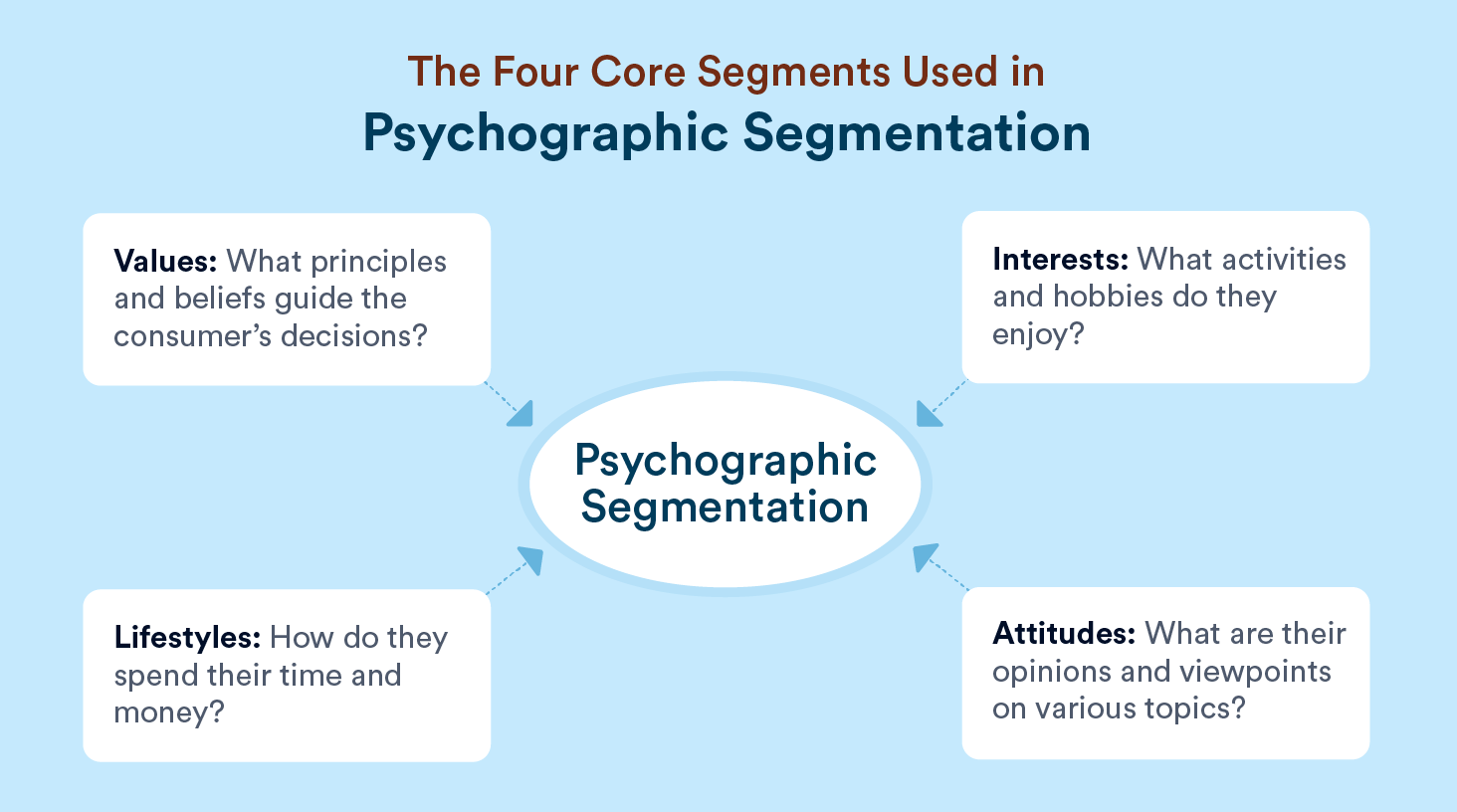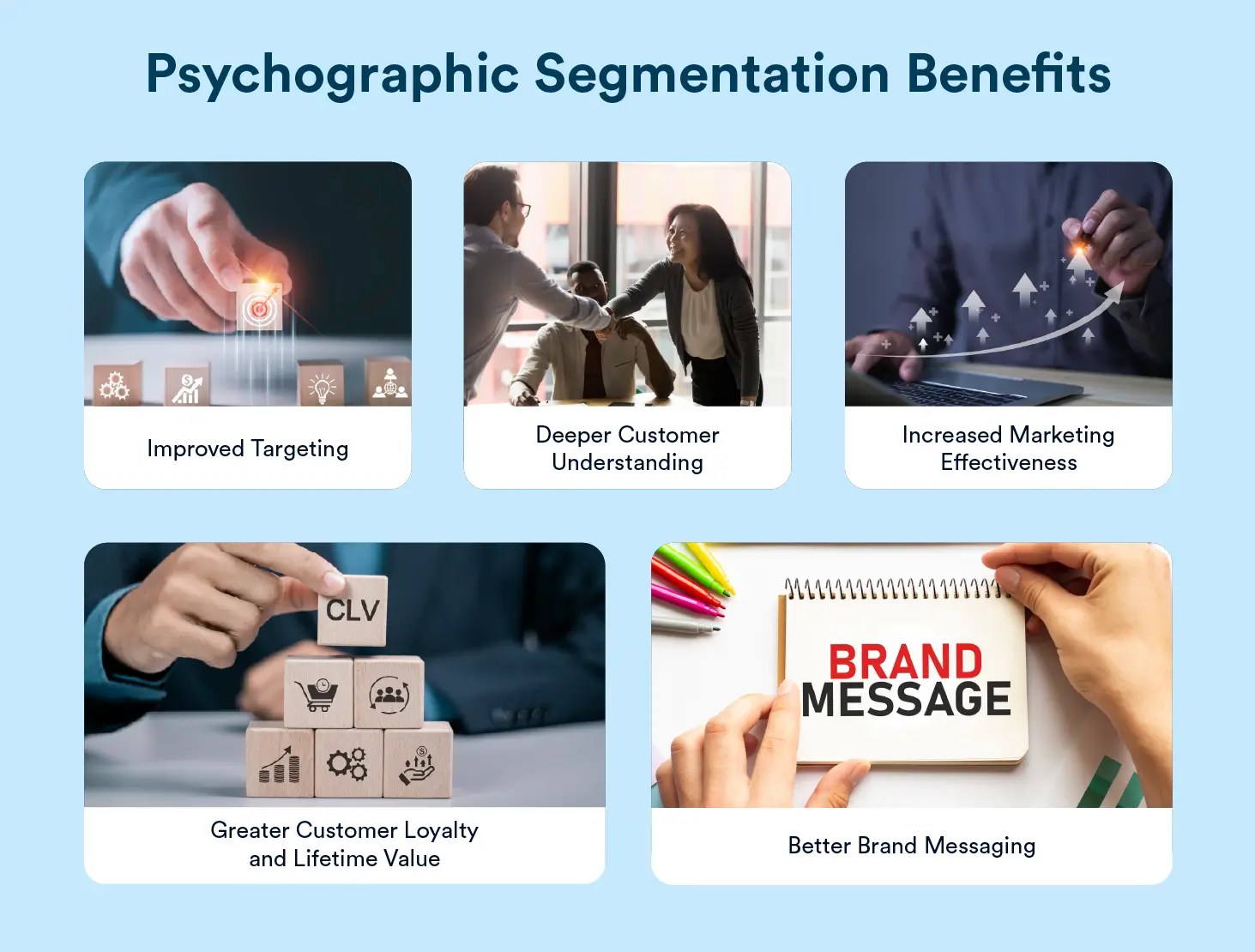Companies use psychographic segmentation to better understand what motivates their audiences and create more personalized marketing strategies. In this article, we’ll explore how you can make it work for your business.
What is Psychographic Segmentation?
Psychographic segmentation is a marketing strategy that divides consumers into groups based on their psychological traits. Unlike demographic segmentation, which focuses on measurable statistics like age and income, psychographic segmentation delves deeper into the emotional and mental aspects that drive consumer behavior.
Psychographic segmentation is a type of customer segmentation. It typically uses four core traits to define segments:
- Values: What principles and beliefs guide the consumer’s decisions?
- Interests: What activities and hobbies do they enjoy?
- Lifestyles: How do they spend their time and money?
- Attitudes: What are their opinions and viewpoints on various topics?

By understanding these components, we can create more targeted and effective marketing strategies that resonate with our audience on a deeper level.
Psychographic Segmentation Benefits
Here are some of the ways psychographic segmentation can elevate how you connect with your customers:

Improved Targeting
One of the primary benefits of psychographic segmentation is more precise targeting. Understanding your audience’s psychological traits allows you to create marketing campaigns that speak directly to their values, interests, and lifestyles. This means your messages are more likely to resonate, leading to higher engagement and conversion rates. Instead of casting a wide net, you can focus your efforts on those most likely to be interested in your products or services.
Deeper Customer Understanding
Psychographic segmentation helps you gain a deeper understanding of your customers. By delving into their attitudes and opinions, you can uncover what truly makes them tick. These insights allow you to tailor your offerings to better meet their needs and preferences. For example, if you know that a segment of your audience values sustainability, you can highlight your eco-friendly practices in your marketing materials. This attracts like-minded customers and builds stronger, more meaningful relationships.
Increased Marketing Effectiveness
Aligning your marketing strategies with your audience’s psychographic profiles can significantly boost your campaigns’ overall effectiveness. Personalized messages that reflect the values and interests of your target segments are more likely to capture attention and drive action. You can then concentrate your efforts on those most likely to convert, which translates to a better ROI on your marketing spend. Psychographic segmentation can also help you identify new market opportunities and niches you may have overlooked.
Greater Customer Loyalty and Lifetime Value
Psychographic segmentation helps you make your customers feel understood and valued, customers who will keep coming back, thus improving customer lifetime value (CLV). What’s more, as you grow a base of loyal customers who trust your product, you are creating a small army of brand ambassadors.
Better Brand Messaging
Companies need messaging that goes beyond communicating what their product does; it needs to be dialed into their audience’s core needs and desires. Psychographic segmentation delivers profound emotional insights that can be used to craft powerful messaging that will resonate with potential buyers and draw them in.
Psychographic Segmentation Examples

Now that you know why psychographic segmentation has become such an indispensable tool, let’s delve into some concrete examples across different industries to see how these segmentation strategies can be practically applied.
Lifestyle Segmentation
Lifestyle segmentation focuses on how people live their lives, including their daily activities, interests, and opinions. For instance, a company selling outdoor gear might target individuals who enjoy hiking, camping, and other outdoor activities. By understanding these lifestyle choices, the company can tailor its marketing messages to highlight the benefits of its products for enhancing outdoor experiences. This approach helps create a strong connection with the audience, making them feel understood and valued.
Values and Attitudes Segmentation
Values and attitudes segmentation dives into the core beliefs and viewpoints that drive consumer behavior. For example, a brand that promotes sustainability might target consumers who prioritize eco-friendly practices and ethical consumption. By aligning marketing strategies with these values, the brand can create campaigns that resonate deeply with this audience. This attracts like-minded customers and fosters loyalty and trust, as consumers feel that the brand shares their principles.
Personality Trait Segmentation
Personality trait segmentation categorizes consumers based on their inherent characteristics, such as introversion, extroversion, openness, and conscientiousness. For example, a travel company might target adventurous and open-minded individuals with marketing campaigns that emphasize exotic destinations and unique experiences.
Or, a home decor brand might focus on consumers who value comfort and stability, highlighting products that enhance the coziness and functionality of their living spaces. By tapping into these personality traits, brands can create more personalized and appealing marketing messages.
Travel & Transportation
The marketing team for a travel site notices a group of users that have purchased multiple flights between the same departing and destination cities — and never fly on the weekend. The marketers extrapolate that these customers are flying for business and can start to narrow down their campaign strategy. One campaign might be to offer free WiFi or upgrades to business class with the purchase of their next flight through the mobile app. Since the traveler likely charges the flight to the company, offering them personally a unique value will likely influence their decision to buy.
Food Tech
A food delivery app notices that a group of users place their orders late on Friday and Saturday nights. The team reasons that these users are ordering after a night out. Even though these users have only ever ordered on weekend nights, they argue that national holidays will likely have a similar effect on ordering habits. Establishing a campaign targeting these users on St. Patrick’s Day, Independence Day, and New Year’s Eve would be a good fit for this psychographic segment.
Media & Entertainment
A sports news app realizes that some customers only engage with the app on game day unless the news is about their favorite team. Since a large portion of fans don’t live in the same city as their favorite team, location services will not help the marketing team serve these consumers with information they are interested in. Using psychographic segmentation based on the previous content they’ve engaged with, news updates can be tailored for users within this psychographic segment.
How to Develop Psychographic Segments
Now that you know the what’s and why’s of psychographic segmentation, you can start putting together some action steps for how to create your own. Generally speaking, the following steps make up the foundational work you’ll need to do to get started:
- Conduct Market Research
To develop your own psychographic segments, start by conducting thorough market research. This involves gathering data on your target audience’s values, interests, lifestyles, and attitudes. You can use surveys, focus groups, and interviews to collect this information. Online tools like social media analytics and customer feedback platforms can also provide valuable insights. The goal is to identify and understand the psychological factors that drive your audience’s buying decisions. - Analyze Data
The next step is to analyze the data, looking for patterns and trends to help you identify distinct psychographic segments. Use statistical tools and software to process the data and uncover correlations between different psychological traits. For example, you might find that a significant portion of your audience values sustainability and enjoys outdoor activities. This information can help you create a segment of eco-conscious adventurers. - Identify Common Patterns
After analyzing the data, identify common patterns that emerge. These patterns will help you define your psychographic segments more clearly. Group individuals who share similar values, interests, and lifestyles. For example, you might identify a segment of tech-savvy professionals who prioritize innovation and efficiency. By recognizing these commonalities, you can tailor your marketing strategies to resonate with each specific segment, making your campaigns that much more effective and engaging.
Creating a Buyer Persona for Psychographic Segmentation
Creating a buyer persona for psychographic segmentation involves three key steps:
Define Demographics
Before diving into psychographic characteristics, it’s essential to start with demographics. Demographics provide the foundational data about your audience, such as age, gender, income, education, and occupation. This information helps you understand the basic profile of your target market. For instance, knowing that your primary audience consists of young professionals aged 25-35 with a median income of $60,000 can guide your initial lifecycle marketing strategies. However, more than demographics is needed to paint the complete picture, and this is where psychographic segmentation comes into play.
Identify Psychographic Characteristics
Once you clearly understand your audience’s demographics, you can delve into their psychographic characteristics. These include values, interests, lifestyles, and attitudes. For example, you might discover that your target audience values sustainability, enjoys outdoor activities, and has a positive attitude toward technological innovation. You can use surveys, focus groups, and social media analytics to gather this information. The goal is to uncover the psychological factors influencing your audience’s buying decisions.
Develop a Detailed Profile
With both demographic and psychographic data in hand, you can now develop a detailed buyer persona. This persona should be a comprehensive representation of your ideal customer, combining both sets of characteristics.
For instance, your buyer persona might be “Eco-conscious Emma,” a 30-year-old marketing professional who values sustainability, enjoys hiking, and prefers eco-friendly brands. By creating such a detailed profile, you can tailor your marketing messages to resonate deeply with this persona, making your campaigns more effective and engaging.
This approach helps you understand your audience on a more profound level, allowing you to create more personalized and effective marketing strategies.

Read More: Understanding Behavioral Segmentation in Marketing with Examples & Strategies
Examples of Companies Using Psychographic Segmentation
Psychographic segmentation allows companies to zero in on what matters most to their audience and connect more deeply with their target segments by addressing their unique motivations and preferences. Below are some notable examples of companies effectively using psychographic segmentation to engage and resonate with their audiences:
1. Nike – Targeting Athletes and Fitness Enthusiasts
Nike excels at targeting athletes and fitness enthusiasts by focusing on their passion for sports and active lifestyles. The brand’s marketing campaigns often feature professional athletes and motivational messages that resonate with individuals who prioritize physical fitness and performance. By understanding the values and interests of this segment, Nike creates products and advertisements that inspire and engage their audience.
2. Spotify – Targeting Music Lovers and Trendsetters
Spotify uses psychographic segmentation to target music lovers and trendsetters. The platform offers personalized playlists and recommendations based on users’ listening habits, moods, and preferences. By tapping into the emotional connection people have with music, Spotify creates a unique and engaging user experience that keeps subscribers coming back for more.
3. Airbnb – Targeting Travelers with Unique Experiences
Airbnb targets travelers seeking unique and authentic experiences. The platform highlights distinctive accommodations and local experiences that appeal to adventurous and open-minded individuals. By understanding the desire for personalized and memorable travel experiences, Airbnb effectively connects with a segment of travelers who value exploration and cultural immersion.
4. Apple – Targeting Innovators and Design Enthusiasts
Apple targets innovators and design enthusiasts by emphasizing cutting-edge technology and sleek, user-friendly designs. The brand’s marketing campaigns often showcase their products’ innovative features and aesthetic appeal, appealing to consumers who value creativity, efficiency, and style. This approach helps Apple maintain a loyal customer base that eagerly anticipates new product releases.
5. Tesla – Targeting Environmentally Conscious and Tech-Savvy Customers
Tesla targets environmentally conscious and tech-savvy customers by promoting the sustainability and advanced technology of their electric vehicles. The brand’s marketing messages highlight the environmental benefits of electric cars and the innovative features that set Tesla apart from traditional automakers. This strategy resonates with consumers who prioritize eco-friendly practices and cutting-edge technology.
6. Patagonia – Targeting Outdoor Enthusiasts and Eco-Friendly Consumers
Patagonia targets outdoor enthusiasts and eco-friendly consumers by emphasizing their commitment to environmental sustainability and high-quality outdoor gear. The brand’s marketing campaigns often focus on their eco-friendly practices and the durability of their products, appealing to individuals who value nature and responsible consumption. This approach helps Patagonia build a strong connection with their audience, fostering customer loyalty and trust.
You Might Like to Read: What is Market Segmentation? Definition, Types & Examples
Building Psychographic Segments with CleverTap
Brands can leverage CleverTap for psychographic segmentation to deeply understand and effectively engage their audience based on lifestyle, interests, attitudes, and values. Using CleverTap’s advanced analytics and customer profiling capabilities, brands can create detailed psychographic profiles. For instance, a fitness app can segment users into groups such as ‘health enthusiasts,’ ‘casual exercisers,’ and ‘weight loss seekers.’ By understanding the distinct motivations and interests of each group, the app can tailor its messaging and in-app experiences accordingly.
CleverTap’s real-time behavioral analytics, powered by Clever.AI, allow brands to track user interactions and identify patterns that reveal specific psychographic traits. This AI-driven insight helps brands tailor their communication strategies, sending personalized push notifications, emails, and in-app messages that align with each segment’s interests and values. For instance, Clever.ai can discern between a ‘health enthusiast’ and a ‘casual exerciser,’ enabling brands to deliver advanced workout content to the former and motivational tips to the latter, enhancing relevance and engagement.
Finally, CleverTap’s A/B testing feature enables brands to experiment with different messages and offers, optimizing campaigns to better appeal to each psychographic segment. This targeted approach not only enhances user engagement and satisfaction but also drives higher conversion rates and loyalty.
Subharun Mukherjee 
Heads Cross-Functional Marketing.Expert in SaaS Product Marketing, CX & GTM strategies.
Free Customer Engagement Guides
Join our newsletter for actionable tips and proven strategies to grow your business and engage your customers.















































